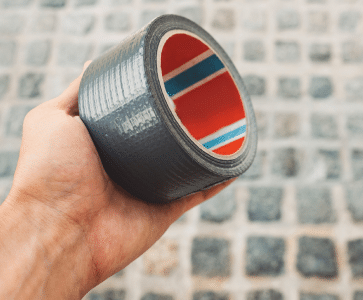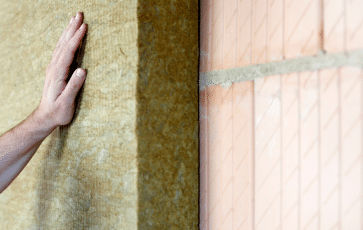Asbestos-Wrapped Ducts
Asbestos duct tape can commonly be found on the ductwork of forced air heating systems installed between the 1950s and 1980s. This material was used to seal air gaps where the ductwork joints met. It was also common for ductwork to be fully covered with asbestos-insulating material. Asbestos-wrapped ducts may pose unreasonable risks to human health if they become damaged. If you or a loved one has been diagnosed with mesothelioma, contact the Lanier Law Firm today for a free consultation.
Home » National Mesothelioma Law Firm » Asbestos Exposure » Asbestos in Consumer Products and Materials » Asbestos-Wrapped Ductwork
Asbestos was highly regarded by asbestos companies for its ability to insulate against fire, heat, and moisture while strengthening the materials to which it was added. The strong fibers were flexible enough to be woven into a variety of materials and resistant to decay. As a result, it was widely used for ductwork insulation.
Asbestos-wrapped ducts may be found in attics and crawl spaces where ductwork is found. It can also be found in boiler rooms and industrial heaters. It was generally used from the mid-1950s until the early 1980s, but began a marked decline during the 1970s, according to Asbestos 123, an asbestos testing company.
When asbestos-containing materials are damaged, they release hazardous asbestos fibers into the air, where they can be inhaled. This poses an unreasonable risk to homeowners and workers who handle it directly or are bystanders in the vicinity where asbestos is airborne.
Who is most at risk of being exposed to asbestos in ducts?
Workers who manufactured, installed, maintained, or removed asbestos-wrapped ductwork faced the highest risk of asbestos exposure through ductwork. Workers also faced increased risks during activities that required the materials to become damaged, such as repairs, removal, renovations, and demolitions.
Workers may still face occupational exposure to asbestos today when working on or near heating systems in older homes, businesses, or factories. This includes workers most likely to encounter asbestos in wrapped ductwork, such as:
- Heating, ventilation, and air conditioning (HVAC) contractors
- Insulators
- Plumbers
- Maintenance workers
- Construction workers
- Factory workers
- Millwrights
- Engineers
- Boiler workers
- Demolition workers
- Firefighters
Homeowners and renters living in older houses are also at risk of asbestos exposure from ductwork, especially if they are do-it-yourself types who perform work on the ductwork.
Asbestos was sometimes used as a lining inside the ductwork, according to Priority Abatement & Remediation, resulting in heavy, prolonged asbestos exposure for people living in these homes if the lining wears down or becomes damaged. This would allow asbestos to travel into the living areas through the vents.
Types of Asbestos Duct Wrapping
Asbestos was primarily applied to the ductwork at the elbows and joints where separate ducts met in order to prevent forced air from escaping out of the vents. This increased the efficiency of the heating system and prevented fires.
Duct Tape
The asbestos duct tape used in heating ducts was also known as joint sealant. It differed from modern-day duct tape in that it was a thicker material with a fibrous appearance. The coloration was white or gray. According to Fairbairn Inspection Services, it looked like a mix of cloth and plaster around the joints.
Asbestos duct tape typically has a concentration of 35 to 65 percent chrysotile asbestos. It is not uncommon to find it in good condition, which may mean that it is not releasing asbestos fibers. However, it is easily damaged. Merely peeling it off of the ductwork can release asbestos.

Paper Insulation
According to Al’s Plumbing, paper insulation was applied to the entire length of the ductwork while it was wet so that it would be securely fastened upon drying. It was most commonly found on the outside of the ductwork, but it was occasionally placed inside.
If located inside, it can be difficult to identify because the register supply or return grills would have to be removed in order to see it, according to Indoor Science, an asbestos testing company.

Vibration Dampening Cloth
Vibration dampeners, also known as dampers, are installed between the air handler and metal ductwork to absorb vibrations. This prevents bothersome noises from being heard throughout the building while the forced air unit is operating. Vibration dampeners were typically made of a rubberized material.
However, some older units were fitted with asbestos cloth noise dampers, according to Inspectapedia. These typically contained a high concentration of chrysotile asbestos and had a white, white-gray, or silver appearance, depending on whether it was uncoated or aluminum-coated. Since these are located inside the ductwork, any damage to this material could release asbestos throughout the building.

Asbestos Cement Ductwork
In some older houses, the ductwork itself is made of asbestos cement. This can be quite hazardous because if the cement begins to break down inside the ductwork, asbestos fibers can be released throughout the home. These can be difficult to remediate because cement ductwork was often built into the slab or under a basement.
According to Asbestos 123, asbestos cement ductwork was also used as gas vents in appliances like furnaces, boilers, and water heaters. If the concrete pipe is ragged when cut, it is a telltale sign that the product is asbestos cement. The ragged edges are caused by the fibrous nature of asbestos.

Safety Measures for Handling and Maintaining Ductwork Wrapped in Asbestos
Air duct tape or insulation should be removed if it has sagged, collapsed, or become friable. Friable asbestos can easily be released through hand pressure. If the material is intact and undamaged, the safest and least expensive option may be to simply encapsulate it.
This can also be an effective remedy if the asbestos insulation is located inside the ductwork or if the ductwork is itself asbestos cement. However, if it is damaged, it should be removed by a licensed asbestos abatement company.
If the asbestos duct wrapping is in good condition and you choose to leave it as is, consider abiding by the following guidelines to protect the health and safety of everyone in the building:
- Avoid touching or bumping the material.
- Avoid being in the area to the fullest extent possible.
- Do not attempt to peel off the asbestos tape or wrapping.
- Do not damage the wrapping by cutting, puncturing, drilling, or scraping it.
- If you change your ductwork, hire an asbestos abatement company to remove the tape or insulation before initiating this process.
- Have the material inspected periodically on the schedule recommended by a licensed asbestos inspector in your area.
Health Effects of Asbestos Duct Exposure
Asbestos duct tape and wrapping on the outside of your HVAC ductwork are unlikely to cause serious health problems if it is in good condition and remains undisturbed. If it is damaged, you could risk your health every time you are in the same room with it, and it could spread throughout your home on your clothes or when you open the door to the contaminated area.
If the asbestos-containing material is located inside the ductwork, it is very hazardous and could jeopardize the health of your entire family. This is true whether you have damaged asbestos insulation inside your ductwork, asbestos cement pipes that wear down on the inside, or a damaged sound dampener.
If you worked with HVAC ductwork daily in your occupation, you may have experienced frequent, heavy asbestos exposure over an extended period. Workers with this pattern of exposure have the highest risks of developing serious asbestos-related illnesses 10 to 60 years later, including the following:
- Mesothelioma – An aggressive, deadly cancer that impacts the lining surrounding certain internal organs, most commonly the lungs or stomach
- Lung cancer
- Asbestosis – Scarring of the lungs
There is no cure for these conditions, and they are generally associated with a poor prognosis and drastically shortened life expectancy.
Companies with a History of Exposing Workers to Asbestos-Wrapped Ducts
The following asbestos companies have a history of manufacturing or supplying asbestos-containing products that were used in ductwork:
- Albany International Corp.
- A.O. Smith
- Burnham Pump Company
- Dunham Bush, Inc.
- Duro-Dyne
- H.B. Smith Company
- Johns Manville
- W.R. Grace Corporation
- Rich Tex Inc.
- Georgia-Pacific
- Celotex
- Grant Wilson
- H.B. Fuller
- Nicolet
- Owens Corning
- Turner & Newall
How The Lanier Law Firm Can Help
If you have developed mesothelioma after being exposed to asbestos in ductwork, you may have grounds to file a mesothelioma claim for significant financial compensation against the companies that caused or contributed to your exposure.
These companies marketed and sold asbestos long after they knew it was harmful. Our experienced and devoted mesothelioma lawyers are passionate about getting justice for our deserving clients.
Our attorneys have won nearly $20 billion in verdicts and settlements for clients injured through no fault of their own. With over 30 years of experience fighting for people who have developed devastating illnesses after being wrongfully exposed to asbestos, we know what it takes to win. Contact us today for a free consultation.
By submitting this form, you agree to our terms & conditions. Please read the full disclaimer



